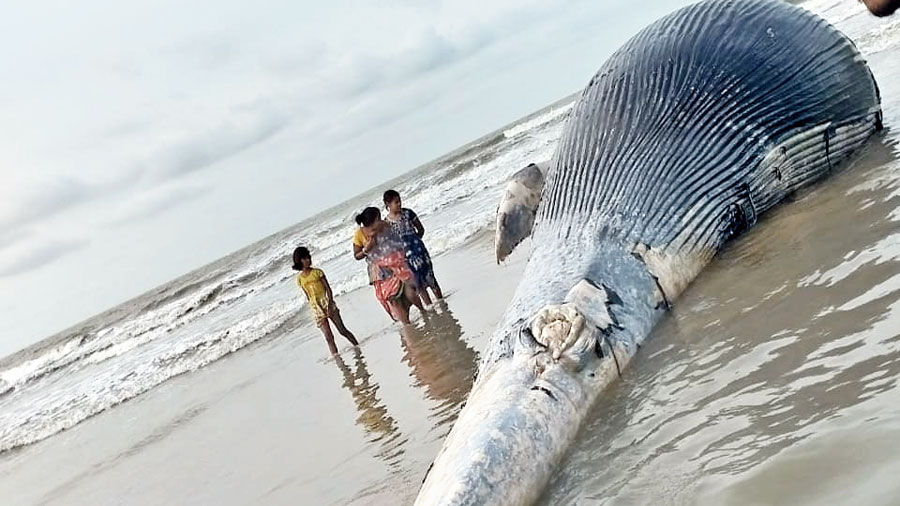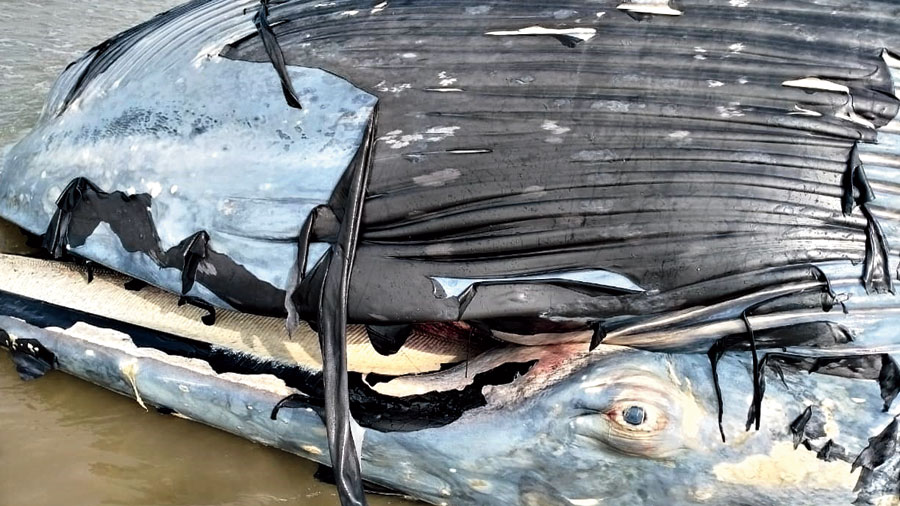The carcass of a giant whale, with fins the size of an adult human being, was washed ashore at the Mandarmani beach on Monday morning.
The body was over 40ft-long and weighed around 50,000kg, according to an estimate provided by forest department officials who reached the spot after fishermen saw the carcass early on Monday.
Whales do not end up lifeless in Bengal’s beaches regularly. Forest officials — local and those posted at the headquarters —struggled to identify the mammal till evening. The popular beach resort is devoid of tourists because of Covid-19 curbs but a sizable crowd gathered around the carcass, with a rush to take selfies with it.
A marine biologist with the Zoological Survey of India examined the carcass later in the day. He identified the carcass as that of a Bryde’s whale, one of the four confirmed species of baleen whales found in Indian waters.

The whale’s body was partly decomposed and was buried after the ZSI inspection with the help of an excavator Jahangir Badshah
Baleen whales are cetaceans (aquatic mammals like whales and dolphins) that have baleen plates, and not teeth, like dolphins. Baleen plates act like a sieve, filtering the whale’s prey from seawater. Baleen is made out of keratin, the same protein that makes up human nails and hair.
The other three species found in Indian waters are Blue whales, Omura’s whales and Humpback whales.
“The body was that of a female. It was over 40ft-long and weighed around 50 tonnes. The pectoral fins that act as rudders of whales were 5.5ft in length,” S.Balakrishnan, a ZSI scientist, said.
The skeleton of a male of the same species that was washed ashore in Digha in 2012 is preserved at the centre, Balakrishnan, who is in charge of the Marine Aquarium and Regional Centre, Digha, said.

A marine biologist with the Zoological Survey of India identified the carcass as that of a Bryde’s whale Jahangir Badshah
“Bryde’s have a straight rostrum (the snout-like extension of the jaw) with three longitudinal ridges that extend from the blowholes (the hole at the top of the head through which the whale breathes air), where the auxiliary ridges begin as depressions, to the tip of the rostrum,” he told The Telegraph.
The whale’s body was partly decomposed and was buried after the ZSI inspection with the help of an excavator, a forest official said.
Dipani Sutaria, an ecologist studying marine cetaceans in India and part of Marine Mammal Research and Conservation Network of India, saw the pictures of the carcass.
“It is possible to identify the species given a number of features are visible or available. In this particular case, we cannot see the rostrum. If it has three ridges it is a Bryde’s whale. The jaw shape and the flipper shape rule out Blue whales and Humpback whales,” she said.
Since the carcass was spotted, rumours flew thick and fast on how the animal died and was washed ashore. “It could have been because of Cyclone Amphan,” a forest official told The Telegraph in the morning.
Sutaria had a clearer explanation. “The cause of death is not easy to assess — but some of the threats facing Baleen whales is lack of prey availability, fishing gear entanglement, seismic surveys and similar underwater noise and shipping vessel strikes. Natural causes include disease and age-related mortality,” she said.
Additional reporting by Angshuman Phadikar











